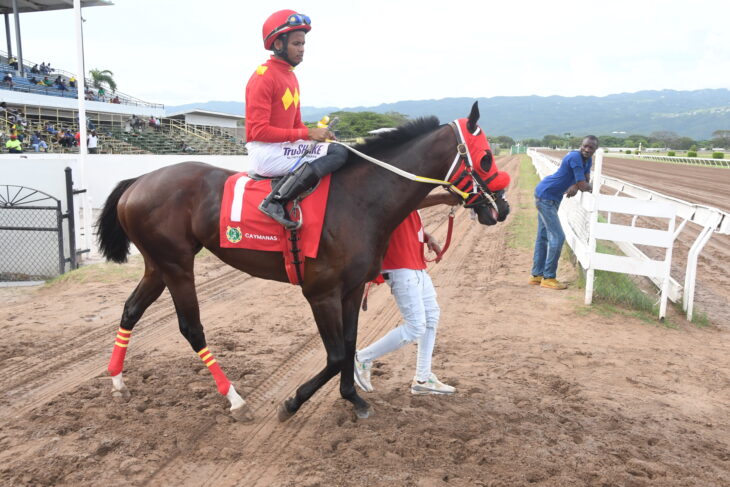
At the races, punters endure a barrage of declared and undeclared equipment changes often made to confuse us and mask larcenous intent.
The only way to combat these mind-flaying attacks is to know the purpose of every bit of equipment fitted to a horse (especially its head or face); keep tabs on which equipment is used when; and pay close attention to when an equipment change is positive or negative.
It all begins, as does everything else in racing, with the horse. This is why public tipsters get it wrong on most occasions because, by and large, they use the race book as a Mathematics text completely forgetting that horses are people too. Some are moody; some temperamental; some roguish; some inquisitive; and a special few, like legendary mare Bonnie Blue Flag, are calm, docile and relaxed at home but tigers when the gates open.
The true purpose of headgear is to try to convert as many of the first three categories into as many Bonnie Blue Flags as possible. But, often, a trainer’s intent is the other way around. With scant information, we must sift the wheat from the chaff. That’s an impossible task if we don’t even know what each type of headgear does. So let’s learn here.
Blinkers are the best known and most often used headgear. They encourage a horse to concentrate. You’ll know a horse needs blinkers if you see it looking around during the race (beforehand is okay) or generally not focusing on the task at hand. American horsemen (who are copied by too many Jamaican trainers) have no problem taking the lazy short-cut of starting a horse in blinkers on debut. It’s rare in England. The professional approach is to wait for a horse to show you IN A RACE that it needs blinkers.
So when a trainer declares blinkers for the first time after a horse has raced more than once, that’s a diligent trainer. But blinkers are teaching tools, NOT permanent companions. An improved effort in first-time blinkers isn’t guaranteed to be repeated. Even if it is, there’ll come a time, sooner than later, when the horse has learned its lesson and blinkers should be removed.
Visors are blinkers with a hole in each to give the horse limited peripheral vision. This balances normal curiosity with the need to focus for a horse that doesn’t need the intensely narrow focus of full blinkers.
In the early days of visors, I owned a filly declared to run in an important race in visors but then the trainer belatedly rethought the strategy. The stewards wouldn’t permit a late change so he simply cut off most of the cup, leaving only about a half inch. She was presented to the stewards as a horse in visors with very big holes. They fumed but could do nothing. She trotted up in the race.
Today I see where tongue straps come loose at the gates and the stewards permit the horse to run (if the trainer consents) without the tongue strap but an announcement is made so punters are aware. So why not permit a late change of any declared equipment (for good reason) once it’s announced?
Cheek Pieces are visors for rogues because they give the illusion of no headgear while restricting peripheral vision. When a trainer reaches for those it usually means trouble. But many improve with cheek pieces.
A Hood is worn to calm down temperamental horses or those that become antsy or excitable especially in the preliminaries. It’s important to note that a thoroughbred’s daily routine is a solitary one where the groom is his only constant companion. When he exercises in the mornings there’s practically nobody there. Then, suddenly, one afternoon, it’s exposed to a loud crowd and too many other strange horses. Some don’t handle the transition well. The soothing feel of the material covering its head (except for the eyes) and ears calms it down. Local conditioners still haven’t learned the “trick” of fitting an undeclared hood until the horse is about to be loaded then taking it off. Because, in the race, the hood calms it down as well. So watch for those that run poorly in a hood for a while then have it removed.
Nosebands are also for focus by different means. The sheepskin noseband (shadow roll) gives the horse something to concentrate on during the race. The crossed noseband (bit holder) also keeps the bit from slipping and gives the jockey more control.
A Chest-strap (or wind strap) primarily helps the horse to regulate its breathing while a neck-strap gives the jockey something extra to hold onto if he needs more control.
A Tongue-strap (or Tongue-tie) prevents horses prone to swallowing their tongue from indulging in that bad habit while a Figure Eight keeps the mouth closed thus preventing horses from “sucking wind”. Improved respiration means improved performance. Horses are people too!
These days many horses wear an undeclared Breathing Strip on their nose. This acts like an anti-snoring strip in humans and helps the horse with its breathing, especially as soft palate operations are not yet in vogue here.
Go to the races. Watch the pre-paddock; saddling barn; parade ring; post parade; and going to post of every horse in every race. Take notes. Pay attention. These things can be very helpful if you want to escape the clutches of horseracing pimps and touts; make your own selections; enjoy yourself immeasurably more; and minimize losses.
DEPARTMENTS:
Clocked-In
Abbreviations: CT = “Corrected Time”; TV = “Track Variant” (a calculation of track conditions’ effect on official times to arrive at “real/corrected” times); TVs are expressed in fifths of a second; “minus” (-) means a fast track; “plus” (+) a slow track (e.g -2 is fast by 2/5th second). Variants beside horse’s names represent the difference between its official time and the grade standard.
Last time we were together I wrote about Don Vicenzo as “a late foal so the Derby probably came too soon but he’s developing into an above average stayer. His staying on second [in a 1,500m 3yo maiden condition] in 1:35.1 converts to a CT of 1:34.3 – over a second faster than the grade standard. Losses are only lent.”
On September 24, he was stepped up to 1,600m in a higher grade (3yo maiden special weight); gave the race away at the start but rallied to have every chance 400m out before being repeatedly hemmed in on the rails by the eventual narrow winner. He was subsequently awarded the race.
SEPTEMBER 24, 2022 [TV+0.3 per 200m (Round); -1 (straight)]
Awesome Anthony (-5) confirmed his promising debut and his unimaginative name with a facile 12 lengths win (Race 2; two-year-olds; maiden special weight; 1,000m round; TV+1.5) clocking 1:00.1! His CT (0.59.4½) is already 7/10th second faster that 3yonw3 and only 1/10th second slower than Overnight Allowance standard. At this minimum trip that makes him an exciting prospect. He’s one to follow.
Overseas Betting Opportunities (OBOs)
On Sunday one of Europe’s most prestigious races, The Prix de l’Arc De Triomphe (“The Arc”) will be run at Longchamp in France over 12 furlongs. It’s a European Championship race with the best three-year-olds meeting the best older horses on a right-handed track with three home turns. It’s closest English equivalent would be Goodwood.
It’s a fabulous property boasting 126 stables; 150 betting points (machines and betting windows); 500 screens showing the races; 75 boxes and 18 suites; 10,000 Grandstand seats; and 360° views on every floor all on 55.5 hectares of grounds. Children of all ages are welcome.
One day. One day….
Aidan O’Brien entered this race on Luxembourgh’s calendar from he was a two-year-old. Despite missing the English Derby with injury he has won two 10f races since in workmanlike style showing marked progress on last in the Group 1 10f Irish Champion Stakes (Leopardstown; left-handed). He should relish likely soft ground on Sunday but there remains a doubt regarding a further step up to 12f so, at cramped odds, I must oppose him with Vadeni who looked like a superstar in the French Derby (Chantilly; right-handed; soft) and again in the Coral-Eclipse (Sandown; right-handed; good-firm) before suffering traffic trouble in the Irish Champion Stakes and finishing 1¾ length third.
Now reverting to a right-handed track and looking sure to relish 12f, he’s a confident selection.
Here’s a notebook horse for the winter on the synthetics:
Red Maids [2yo b.f. Invincible Spirit-Desert Blossom (Shamardal)]
Racing Post’s note of her debut in a Kempton fillies maiden (polytrack; 7f; September 12) read “Slowly away, took keen hold, held up in rear, pushed along and headway from 2f out, went fourth over 1f out, pushed out and no impression final 110yds” but didn’t capture the intangibles that include her clocking the best final 3f split in the race from well off the pace (finished 3½ lengths 4th of 11) despite clear signs of greenness. She should improve markedly next time.
Good Luck!



